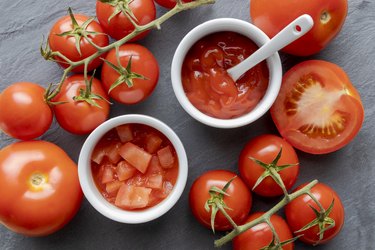
The main difference between tomato puree and tomato paste is the texture — tomato puree is a thick sauce of cooked and strained tomatoes, while tomato paste is concentrated tomatoes that have been cooked, strained and cooked again.
Both may be used in cooking, although they are not interchangeable.
Video of the Day
Video of the Day
Tomato Puree Vs Paste
Tomato puree is a thick puree of cooked tomatoes that is slightly less watery than tomato sauce. It can be used in place of tomato sauce or as a base to begin your own sauce. When it's sold commercially, the ingredients should include just tomatoes and salt.
Tomato paste, quite simply, is concentrated tomatoes. In the store, you'll see small cans, jars or tubes of tomato paste that are significantly smaller than cans of tomato puree or sauce. A look at the ingredients list should reveal only one thing: tomatoes.
If you'd like to make your own puree, the type of tomatoes you use is important. For example, plum or Roma tomatoes perform the best in puree; they are low in water content, with a lot of flavor. However, you could use any kind of tomato you prefer. Tomato paste is also typically made from those varieties of tomatoes and is easy to make at home. Tomatoes can be preserved by canning, drying, freezing or pickling, according to the National Center for Food Preservation.
Tomato Puree in Recipes
To make tomato puree, halve the tomatoes and remove the seeds. (To make a puree without tomato skins, peel the whole tomatoes before you take out the seeds, although it is fine to leave the skins on.) Place the tomatoes in a large, heavy-bottom pot over medium-high heat and bring to a boil. Reduce heat to medium-low and simmer until the tomatoes have released some of their juices and are tender; about 10 minutes.
In a blender, or with an immersion blender, carefully puree the tomatoes until smooth. You may then pressure-can your puree — the USDA gives detailed instructions for home canning — or divide it into resealable plastic bags, press out the air, seal and store flat in the freezer.
There is no true tomato puree substitute, but in a pinch you can use an unflavored tomato sauce and cook it down a little until it thickens and more closely resembles puree. Tomato puree can be used as a base or complement to soups, hearty stews, sauces or pizza, as well as in many pasta dishes, including lasagna and spaghetti bolognese.
Read More: What Type of Acid is In Tomatoes?
Tomato Paste in Recipes
You can also make homemade tomato paste. Again, the type of tomato you use will make a difference in the yield and taste of your finished puree. Plum or Roma tomatoes are a good choice here.
To make tomato paste, quarter your tomatoes and place them in a large, heavy-bottom pot with 2 tablespoons of olive oil. Cook on medium-high, until the tomatoes are soft and breaking down. Push the tomatoes through a food mill or sieve to remove the seeds and skins. Then stir in 2 teaspoons of sea salt and 2 tablespoons of lemon juice.
Divide the tomato pulp between 2 large, rimmed baking sheets, and place it in an oven preheated to 350 degrees Fahrenheit. Bake, checking every 30 minutes, until the tomato pulp has reduced to a thick paste, about 3-4 hours. Place in 4-ounce jars and process in a water bath, freeze or refrigerate — with a thin layer of olive spread on top — for up to a month.
Tomato paste is a pantry workhorse, turning up in recipes like meatloaf, chili, pasta and more. It is typically called for in small amounts, because it is so concentrated. If you have leftover tomato paste, you could stir a few tablespoons into a homemade sauce, spread it across pizza dough before adding toppings or use it to make a warm dip for garlic bread. Because tomato paste is intensely flavorful, you should caramelize it a bit in your pot before adding water and additional ingredients, if you are using it for pasta sauce.
Read More: The Side Effects of Eating Too Many Tomatoes